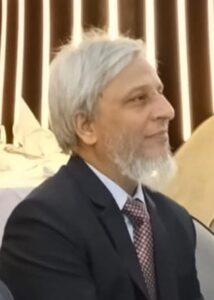
KEYNOTE SPEAKER 1
PROFESSOR DR USMANOV PAZLITDIN NURITDINOVICH
Head of Physics Department, Namangan Institute of Engineering and Technology
Presentation : The properties of even–even deformed nuclei
Abstract
Insufficient knowledge of the properties of strong interactions and the absence of rigorous methods for calculating systems consisting of tens and hundreds of strongly interacting particles forced theorists to perform calculations not of real nuclei, but of some simplified systems called nuclear models. The physical concepts used in constructing the model are based on certain experimental facts. Different models describe different properties of nuclei and processes in them.
We proposed a phenomenological model for studying the properties of rotational states of deformed nuclei, considering the Coriolis mixing of low-lying collective states of positive parity. The eigenvalues and wave functions of the states were obtained by diagonalizing the matrix Hamiltonian of the model using numerical mathematical methods.
Current research work, within the framework of the above-mentioned model, the energy and structure of the wave functions of the states of the main (gr), beta, gamma vibrational and K=1+ bands were determined using perturbation theory, taking into account high orders of corrections to the energies and wave functions.
Specific calculations were performed for deformed nuclei of the rare earth and transuranium regions. The energy and structure of the states of positive parity rotational bands were calculated. The results obtained by perturbation theory are compared with the values determined by numerical diagonalization, which give very good agreement at low spin values, while at high values of spin a slight difference is observed.
Analytical formulas for the probabilities of monopole transitions obtained using wave functions determined by perturbation theory make it possible to determine some energy parameters of the model from experimental data for the probabilities B(E0).

KEYNOTE SPEAKER 2
PROFESSOR DR MOHAMMAD JALAL AHHAMAD
Chairman Department of Mathematics, University of Chittagong
Presentation : Development of CFD methodology for multiphase flow in the fields of petroleum engineering
Abstract
The study of multiphase flow in porous media is an important topic in many disciplines of science and engineering, especially in the field of petroleum engineering. For example, Carbon dioxide (CO2 ) may be injected into an oil reservoir in orderto improve the oil recovery rates, which is called enhanced oil recovery (EOR).
An upscaling methodology for modeling multiscale features of the flow and the porous medium has been studied, where the overall pressure drag and skin friction exerted on the porous medium has been modelled by combining the Darcy’s law with a statistical mechanical theory of viscosity.
A numerical methodology for capturing the multi-physics and multiscale nature of the governing motion has been studied. The temporal discretization employs the second order Crank-Nicolson scheme for viscous and diffusive phenomena, and an explicit method for all other terms. The nonlinear advection terms in the momentum equation has been treated with an Euler explicit flux form central finite difference method; however, the advection of the CO 2 mass flux has been treated with a streamline based Lagrangian method. In order to implement the Marker-and-Cell (MAC) scheme for resolving the incompressibility, a staggered arrangement of the velocity and pressure has been presented on a collocated grid. This approach enhances the implementation of a multigrid solver, and is a novel computational model for simulating miscible displacement processes. The performance of the Lagrangian method has been assessed with respect to an equivalent flux form upwind method.
The results indicate that the viscous forces play a significant role compared to the effect of permeability on miscible displacement of CO 2 and oil, where the injected CO2 displaces the residual oil without being distorted, thereby enhancing the recovery of hydrocarbon. Although the present results with an idealized model lacks from verifications with field measurements, findings of this thesis provide useful feedback to further investigations on CO 2 based EOR techniques.
The modeling of simultaneous flow behavior through a reservoir and wellbore is important and an integrated model is needed which accounts for the transient multiphase flow in the wellbore and its surrounding region. In addition, reservoir and wellbore interface modeling and cost-effective Computational Fluid Dynamics (CFD) methodology are required to simulate the flow behavior in that region.
The study outlines the development of an experimental prototype to study multiphase flow in the near wellbore region. To the best of my knowledge, this facility has the capability to accommodate a larger length scale compared to similar facilities available in the research organizations. This experimental setup can be used for investigating with a wide variety of multiphase flow problems which have been considered in the present research.
A CFD methodology has been developed using the 3D Navier-Stokes equations to simulate an integrated wellbore-reservoir flow. The CFD methodology has been verified for the fluid flow mechanism at near wellbore. The simulations results have been compared to the analytical solutions. Then, this model is extended to establish a coupled wellbore-reservoir framework which is based on 3D Navier-Stokes equations. The simulations have been performed to validate the newly developed CFD algorithm and various scenarios of a reservoir have been taken into consideration. The same process has been applied to investigate flow through a perforated tunnel and a new method of perforation has been discussed.
The study indicates standard CFD techniques use a “numerical approach” such as the volume of fluid accounts for capillary pressure and surface tension force for the flow through porous media. Allen-Chan phase-field method has been combined with the Navier-Stokes equations to simulate multiphase flow in porous media. The simulations performed with the phase-field method have been verified with the experimental data. The experimental and CFD approach of this thesis make a unique contribution in the field of the petroleum industry and multiphase flow in porous media.
